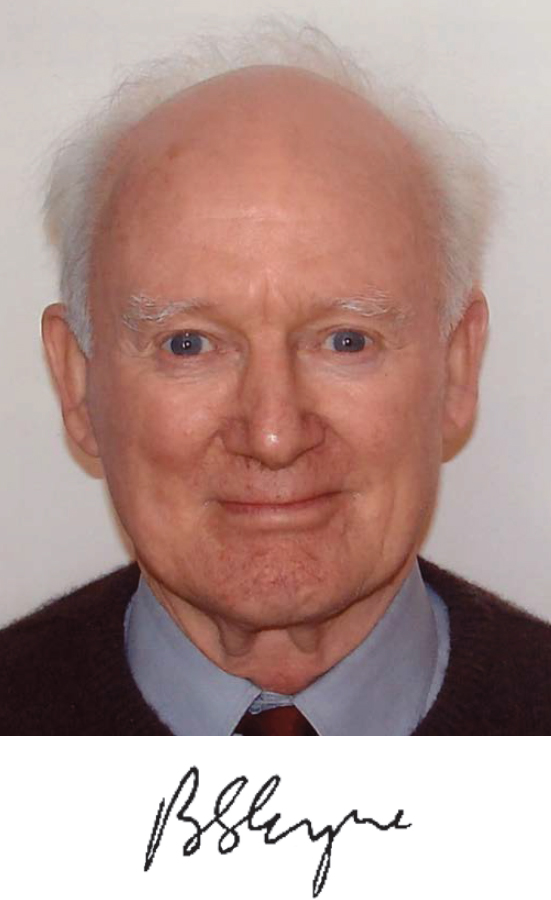BRIAN L. EYRE
1933–2014
Elected in 2009
“For understanding of neutron irradiation-induced damage in materials, and for developing technologies and policies for the UK nuclear industry.”
BY COLIN WINDSOR AND RON BULLOUGH
BRIAN LEONARD EYRE, an outstanding metallurgist who rose to be chief executive of the UK Atomic Energy Authority, died July 28, 2014, at the age of 80.
Brian was born November 29, 1933, the first child of Mabel and Leonard Eyre, in a small terraced house in East London. He did not shine at school but at 15 had the good fortune to get a job with Fairy Aviation as a technical trainee working in the materials laboratory. After seven years of evening study and day release at Wandsworth Technical College, in 1957 he gained a higher national certificate. He had also published two papers relating to the microstructure of tin alloys and was encouraged to study for the newly introduced diploma in technology at Battersea Polytechnic Institute. In 1959, at age 25, he gained a 1st class honors diploma in technology.
He was recruited to the new Berkeley Nuclear Laboratories of the UK Central Electricity Generating Board and soon developed an interest in the metallurgical properties of irradiated metals, which was to be his life’s work.
In 1962 he moved to Harwell, the UK Atomic Energy Research Laboratory, which was then in its golden years as a fountainhead of nuclear research and technology. He soon had his own group in the Metallurgy Division, doing electron transmission microscopy on irradiated metals such as iron and
molybdenum in careful studies of the nature, geometry, and distribution of damage clusters. His expertise in understanding metallurgy from first principles and his interactions with theoretical metallurgists in Harwell’s Theoretical Physics Division led to important joint publications.
Experimental electron microscopy measurements of the shape, size, and orientation of interstitial loops could be explained by analytical calculations of their elastic energy. A later example was in the important practical problem of void swelling, where stainless steel cladding in the Dounreay Fast Reactor was observed to distort because of voids formed by the amalgamation of excess vacancies caused by irradiation. For this problem the experimental data could be fitted by a series of coupled rate equations governing the growth of interstitial loops from the radiation-induced vacancies and their transformation into voids. These rate equations were solved by mainframe computers in those days, and now trivially on a PC.
In 1979 Brian was head-hunted to be the chair of Materials Science at Liverpool University. But his academic career was not to last! In 1984 he was head-hunted once again to come back to the Atomic Energy Authority in a higher management role as director of Fuel and Engineering. The optimistic future envisaged then for nuclear power generation was exploded in 1986 by Chernobyl. At almost the same time a collapse in world oil prices and a torrent of gas from the North Sea meant that Britain had an alternative “dash for gas” path to electricity generation.
Again at almost the same time it became clear that decommissioning Britain’s old nuclear plants would be expensive—indeed, comparable with the income from their future generation capacity. Brian became heavily involved in fighting the government to have a continuing role for nuclear power. In the end the new Pressurized Water Reactor Sizewell B went ahead, generating in 1995, but Britain was to have no new nuclear stations in the 20 years thereafter.
The alternative was to turn the Atomic Energy Authority from nuclear research to contract research on whatever subject could be funded commercially. Brian became chief executive
officer of the authority in 1990 and, following a report by consultants, it was turned into several “businesses,” some nonnuclear. With Brian’s energy and powers of persuasion, this process happened remarkably quickly. It was the era of “privatization” and was supported by the government. The commercial part of the operation became AEA Technology and its shares were successfully sold in 1995 with Brian as deputy chair. It was initially a great success and its shares had tripled in value when Brian retired in 1997. Its success was not to last, though; in 2012 it went into administration.
Brian was elected a fellow of the UK Royal Academy of Engineering in 1992, a Commander of the British Empire in 1993, a fellow of the UK Royal Society in 2001, and a foreign member of the NAE in 2009.
In retirement Brian remained as active as ever from his office at the Oxford University’s Materials Department. But he made time for his love of sailing with his wife Carol, who sadly developed multiple sclerosis. As this advanced Brian turned into a devoted carer. He also became an expert cook, so that dinner with the Eyres remained a very enjoyable gastronomic experience. He is survived by Carol and their two sons, Peter and Steven.





